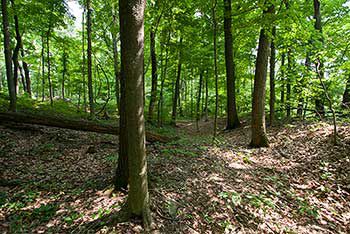FORT HILL,OHIO
fort hill,ohio

Fort Hill, Ohio
Fort Hill is a Native American fortification built by the Hopewell Indians nearly 2,000 years ago, and is one of the best preserved Indian structures in North America. It was built atop a natural hill and towers nearly 500 ft above the forest floor. It was first described in 1838 by Ephraim George Squier. Squier described it as being nearly 1.5 miles in length and encompassing approximately 48 acres. A ditch is located on the inner side of the earthen wall. From the bottom of the ditch to the top of the embankment it measures approximately 15 ft and may have been much taller in the time of the Hopewell. Around the wall are 33 gateways about 15-20 ft in width. The purpose of these gateways is somewhat unclear though it is obvious that they were not used as exits or entrances. They may have been used to release water which would otherwise accumulate in the ditch, or towers may have been built which have since rotted away. Evidence of at least two ceremonial buildings and possibly a small village have been found. Certain areas in the interior of the site were obviously built to hold stores of water.
Ditch and embankment along the edge of the fortification.
Fort Hill was again studied in 1952 by Raymond Baby. His study resulted in the finding of several fire pits, the remains of several buildings, and many Hopewell artifacts. Among the artifacts found was an obsidian knife or spear point. Obsidian is not found in the area of Fort Hill and it remains a mystery as to how the relic came to be at Fort Hill.
Although Fort Hill may have had some religious uses, its primary function was almost certainly military. Some would argue that the openings surrounding the fort would have been difficult to defend and therefore not a stronghold, however, those "entrances" may at one time have been spaces for construction of large towers making the place a strong defensive base. The height of the hill, it's positioning, and the water reservoir also encourage such a theory. Ephraim Squier said this of it:
"Considered in a military point of view, as a work of defense, it is well chosen, well guarded, and, with an adequate force, impregnable to any mode of attack practiced by a rude, or semi-civilized people. As a natural stronghold, it has few equals; and the degree of skill displayed and the amount of labor expended in constructing its artificial defenses, challenge our admiration, and excite our surprise."
Fort Hill is now a State Park and contains over 11 miles of hiking trails, a museum, and recreational picnic areas. It is located off the State Route 41, on State Park Township Road 256, Ohio.
Fort Hill, dans l'Ohio
Fort Hill est une fortification amérindienne construite par les Indiens Hopewell près de 2.000 ans, et est l'un des mieux conservés de structures indiennes en Amérique du Nord. Il a été construit au sommet d'une colline naturelle et près de 500 tours pieds au-dessus du sol de la forêt. Il a été décrit pour la première en 1838 par Ephraim George Squier. Squier a décrit comme étant près de 1,5 miles de longueur et qui s'étend sur environ 48 acres. Un fossé est situé sur le côté intérieur de la paroi de terre. Du fond de la fosse au sommet de la digue, il mesure environ 15 pieds et peuvent avoir été beaucoup plus grand à l'époque de l'Hopewell. Autour de la paroi sont 33 passerelles sur pieds 15-20 largeur. Le but de ces passerelles est un peu flou mais il est évident qu'ils n'ont pas été utilisés comme des sorties ou des entrées. Ils peuvent avoir été utilisés pour libérer l'eau qui, autrement, s'accumulent dans le fossé, ou tours peuvent avoir été construits qui ont pourri depuis. Preuve d'au moins deux bâtiments cérémoniels et, éventuellement, un petit village ont été trouvés. Certaines zones à l'intérieur du site ont été évidemment construit pour accueillir les magasins de l'eau.
Fort Hill
Des fossés et talus le long du bord de la fortification.
Fort Hill a de nouveau été étudiée en 1952 par Raymond bébé. Son étude a abouti à la conclusion de plusieurs foyers, les vestiges de plusieurs bâtiments, et de nombreux artefacts Hopewell. Parmi les artefacts trouvés était un couteau d'obsidienne ou pointe de lance. Obsidian n'est pas trouvé dans la région de Fort Hill et il reste un mystère quant à la façon la relique est venu pour être à Fort Hill.
Bien que Fort Hill peut-être eu certains usages religieux, sa fonction principale était presque certainement militaire. Certains diront que les ouvertures qui entourent le fort aurait été difficile à défendre et donc pas un bastion, cependant, ces "entrées" peuvent à un moment donné ont été des espaces pour la construction de grandes tours faisant la place d'une base solide défensive. La hauteur de la colline, c'est le positionnement, et le réservoir d'eau aussi encourager une telle théorie. Ephraïm Squier dit de lui:
"Considéré dans un point de vue militaire, comme un travail de défense, il est bien choisi, bien gardé, et, avec une force suffisante, imprenable à n'importe quel mode d'attaque pratiquée par un peuple grossier, ou semi-civilisés. Comme un phénomène naturel fief, il a peu d'égaux, et le degré de compétence affichée et la quantité de travail dépensée dans la construction de ses défenses artificielles, remettre en cause notre admiration, et d'exciter notre surprise ".
Fort Hill est maintenant un parc d'état et contient plus de 11 miles de sentiers de randonnée, un musée, et les zones de pique-nique de loisirs. Il est situé au large de la Route 41 Etat, le State Park canton 256, chemin, dans l'Ohio.
 fort hill trail
fort hill trail
 fort hill
fort hill
Inscrivez-vous au site
Soyez prévenu par email des prochaines mises à jour
Rejoignez les 76 autres membres
